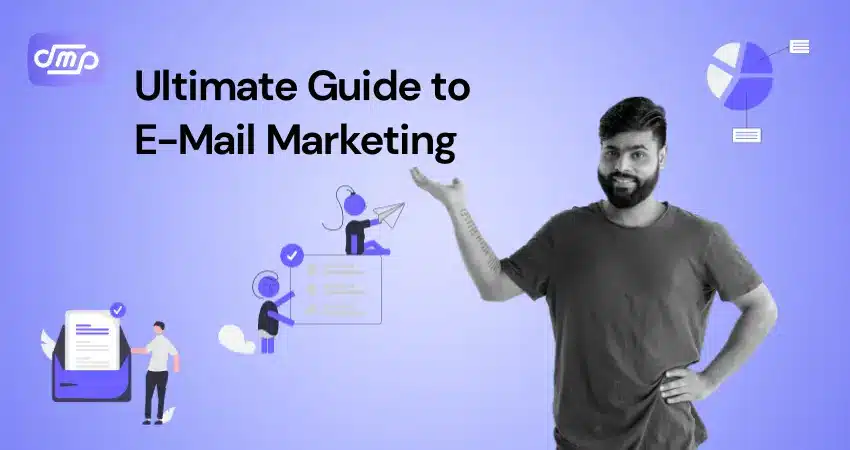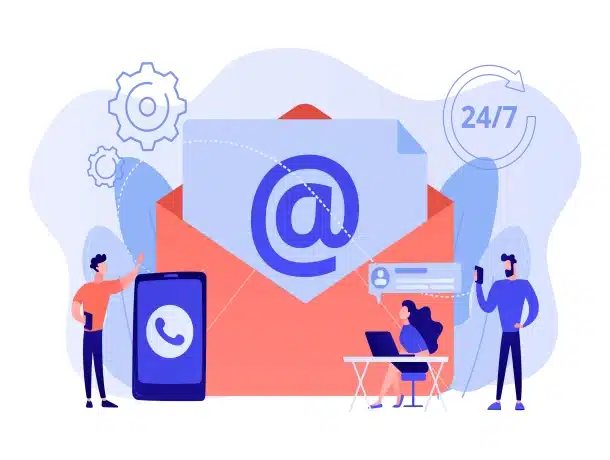
- August 21, 2023
- advertising and marketing, content marketing
- Digital Marketing
What is E-mail Marketing?
Sending marketing materials or adverts to a group of people by email is referred to as email marketing, a type of digital marketing. It is a way for companies to stay in touch with their clients, leads, or subscribers and update them about new products, services, specials, and events.
Guide to email marketing helps in creating an email list of subscribers who have willingly chosen to receive communications from the company is a common step in email marketing campaigns. Depending on the recipient’s interests, preferences, or behaviour, the emails can be tailored and targeted. Emails may also contain calls-to-action (CTAs) that nudge the receiver to perform a certain activity, such as buying something, subscribing to a newsletter, or going to a website.
Email marketing can be a powerful tool for fostering customer relationships and increasing sales, but it requires careful planning and a planned strategy to be effective. A clear message, an alluring subject line, a mobile-responsive design, and a potent CTA are some essential components of a good email marketing campaign.
Guide to E-mail marketing

Sending commercial messages, like adverts or promotional emails, to a group of people via email is known as email marketing. Guide to e-mail marketing helps businesses engage with their customers and potential customers effectively.
The following steps make up the fundamental email marketing process:
- Developing an Email List: Creating an email list is the first stage in email marketing. Obtaining a list of email addresses from people who have expressed interest in your goods or services entails doing this.
- Creating a Campaign: You must create a campaign once you have an email list. To accomplish this, an email message must be written and sent to the list.
- Email Service Provider: Email marketing services are provided by a variety of email service providers. These platforms offer tools for email creation and distribution as well as campaign tracking and analysis.
- Sending the Email: You can send your email to your email list once you’ve created your email campaign and selected an email service provider.
Following the send of your email, you can keep tabs on the campaign’s outcomes. This includes keeping track of the number of recipients that opened your email, clicked on any links, and bought something as a result of it.
Ultimately, a guide to e-mail marketing has the potential to be a potent tool for businesses to connect with their clients and increase revenue. Businesses can utilize email marketing to reach their target audience and expand their business by establishing efficient campaigns, building an email list, and tracking and evaluating outcomes.
Types of E-mail Marketing

Businesses can employ a variety of email marketing campaigns to reach their clients and meet their marketing objectives. To reach their customers and accomplish their marketing objectives, firms can utilise a number of email marketing tactics. The secret is to select the proper campaign type for the company’s unique requirements and target market.
Some of the most popular forms of email marketing are listed below:
Promotional emails: Emails that are intended to promote a particular good or service usually include a discount or special offer. Businesses can generate revenue and drive sales with the use of promotional emails. A promotional email’s main objective is to raise interest in and awareness of the advertised good, service, or event in order to ultimately encourage conversions like purchases, registrations, or attendance.
Promotional emails can be in the form of a discount offer, a product launch notification, an invitation to an event, or a special offer. In order to engage subscribers and urge them to act, they frequently contain persuasive content and visuals, such as pictures or videos.
Businesses of all sizes and industries utilise promotional emails as a crucial part of email marketing campaigns to raise brand awareness, boost sales, and foster client loyalty.
Email newsletters: Email newsletters give subscribers regular updates about the company, such as information on new goods or services, corporate news, or market trends. Emails sent out as part of a newsletter can keep subscribers engaged over time and help businesses develop relationships with them. An email newsletter’s objective is to update and enlighten subscribers about the company, its offerings, and pertinent news and happenings in the sector. Email newsletters come in a variety of formats, including weekly or monthly editions, updates on products, and promotional newsletters. Many types of material, including blog posts, news articles, case studies, event announcements, and special deals, can be included.
Businesses can interact with and remain in touch with their clients and prospects by using email newsletters. Businesses may enhance client retention, foster brand loyalty, and increase traffic to their websites and social media pages by offering pertinent and educational material.
Informational Emails: New subscribers are welcomed with informative welcome emails that introduce them to the company and its offerings. Informational emails can help organisations establish a positive first impression and entice subscribers to interact with subsequent emails. There are various types of email marketing campaigns in that informational emails can be used.
Emails that supply readers with informative and practical content are known as informational emails. They are frequently used to inform readers about a certain subject, offer tips and guidance, or provide updates or news about a particular good or service.
Informational emails can come in a variety of formats, including newsletters, how-to manuals, tutorials, company announcements, industry news updates, and emails with surveys or feedback. An instructive email often contains information that is educational, relevant to the target audience’s interests, and informative.
Typical elements of informational emails include the following:
- Subject lines that are clear and concise and appropriately describe the email’s content.
- Engaging and educational information that benefits subscribers.
- Calls to action (CTAs) that are obvious and prominent and urge subscribers to act.
- Using personalization, such as the recipient’s name or region, can improve the relevance of an email.
- To make sure the email is simple to read and use on mobile devices, it has undergone mobile optimisation.
Informational emails are a powerful tool for companies to interact with their subscribers, give them useful information, and position themselves as an industry leader. These can contribute to the development of enduring relationships with subscribers, which will ultimately increase business income and conversions.
Product update emails: Customers who have added things to their shopping carts but haven’t finished their purchases receive abandoned cart emails. These emails can prompt customers to finish their purchases by bringing to their attention their abandoned shopping cart.
Products or service updates are communicated to subscribers via product update emails, a sort of email communication. These emails are often sent to current clients or subscribers who have shown interest in the goods or services offered by the business.
Emails about new products, features, or problem corrections are a few examples of product update emails. A product update email’s content is often concentrated on the modifications or enhancements made to the product or service and how they will benefit the consumer.
Typical elements of emails with product updates include
- Subject lines that are clear and concise and appropriately describe the email’s content.
- A succinct introduction that emphasises the modifications or improvements made to the good or service.
- Visuals that show off the new features or upgrades, like photos or movies.
- Customers are directed to take action by means of calls-to-action (CTAs) that are obvious and prominent, such as using a new feature or offering feedback.
- Making the email more relevant through personalization, such as leveraging the customer’s name or knowledge of their prior experiences with the good or service.
- Emails that provide updates on new products are a crucial component of a company’s product marketing plan.
- They bring clients up to date on the most recent modifications and enhancements to the product, which can foster loyalty and encourage repeat purchases.
- Product update emails also give businesses the chance to hear from customers, which can help with future product development and enhance the customer experience.
Benefits of E-mail Marketing

Businesses seeking to connect with and engage with their target audience can get many advantages from email marketing.
- Reach: Email marketing enables companies to rapidly and easily reach a large audience. Businesses can communicate with customers worldwide via email at any hour of the day or night.
- Cost-effective: Email marketing is one of the most economical forms of advertising. Email marketing is far less expensive when compared to more conventional marketing strategies like print or television advertisements.
- Personalization: Email marketing enables companies to tailor their communications to each receiver, which can increase conversion and engagement rates. Businesses can send tailored emails to customers who are more likely to respond by segmenting email lists based on demographics, interests, or behaviours.
- Measurable: Email marketing is measurable because it offers organisations precise numbers that let them monitor the success of their efforts. These contain analytics that can help companies optimize their campaigns and raise ROI, such as open rates, click-through rates, and conversion rates.
- Automation: Email marketing automation enables companies to automatically send emails in response to certain events or activities. This can help firms become more efficient and save time so they can concentrate on other aspects of their marketing plan.
- Brand awareness: Email marketing can aid companies in enhancing their brand recognition and solidifying their client relationships. Businesses may position themselves as thought leaders in their sector and gain the trust of their customers by consistently connecting with their audience via email.
Steps involved in creating E-mail marketing
The steps in developing an email marketing campaign are as follows:
- Establish your email marketing objectives: Choose a goal for your email campaigns, such as raising brand awareness, promoting a new product, or telling customers about a promotion or event.
- Create an email list: Get email addresses from people who already do business with you, as well as from website visitors, followers on social media, and other sources.
- Choose a provider of email marketing services: Choose an email marketing solution provider based on your requirements and financial constraints.
- Construct your email marketing message: Create the subject line, body copy, pictures, and call-to-action (CTA) for your email marketing messages.
- Pick a design template: Choose a design template that represents your brand and add your logo, brand colours, and brand images to it.
- Review your email: Test your email before sending it to everyone on your list to make sure it displays properly on all devices and email clients.
- Segment your email list: To deliver tailored communications, divide your email list into smaller groups depending on recipients’ interests, actions, or demographics.
- When to send your email: Based on the behavior, geography, and time zone of your audience, choose the ideal time to send your email.
- Examine and improve your email marketing campaign: Track the results of your email campaign, including open rates, click-through rates, and conversions, and use the information to make your subsequent efforts more effective.
Examples of E-mail Marketing
Listed below are a few instances of email marketing:
- A newsletter is a regular email delivered to subscribers informing them of business updates, industry news, or upcoming events.
- A promotional email is one that encourages the receiver to take action, such as buying something or signing up for an event, by promoting a particular good, service, or event.
- Greetings email, an email that welcomes and introduces new subscribers or consumers to your brand, products, or services.
- Email sent to customers who have left things in their shopping carts but have not completed a transaction in order to persuade them to do so is known as an abandoned cart email.
- An email sent to inactive subscribers to persuade them to reconnect with your company by carrying out a certain action, such as changing their preferences or making a purchase, is referred to as a “re-engagement email.”
- Email sent to clients on their birthdays or anniversaries to wish them well and extend a special promotion or discount.
- An email survey is one that is sent to customers to gather feedback and enhance the customer experience.
- An email sent to clients following a purchase, attendance at an event, or other activity to thank them for their support and provide them with additional support or promotions.
E-mail marketing strategies
These are some email marketing techniques to use when developing successful email campaigns:
- Segment your email list: To deliver tailored communications that connect with each group, divide your email list into smaller groups depending on each group’s interests, behaviour, or demographics. Customize your emails by including subscriber names, purchase information, or other pertinent information to make them more interesting.
- Optimize for mobile: As more and more people read their emails on mobile devices, make sure your emails are mobile-friendly. Due to the lower size of mobile devices compared to desktop screens, it’s critical to keep subject lines brief and to the point, ideally between 30 and 50 characters. With the whole subject line clearly visible, recipients may scan the email’s content with ease. Employ an email layout and design that can be adjusted to accommodate the smaller screen size of mobile devices. As a result, the email will be simple to read and use on all devices. Use a larger font size and legible, easy-to-read fonts to make sure your email content is optimised for mobile devices. To make sure that they display properly and are simple to navigate across a range of screen sizes and resolutions, test your emails across several mobile devices.
- Employ a call-to-action: In your emails, include a call-to-action (CTA) that is obvious and brief to persuade your subscribers to perform a particular action, such as making a purchase or signing up for a webinar.
- Ensure simplicity: Keep your email layout straightforward, with a focused aim and a clear message. Make the email’s content easier to read and skim for recipients by using short paragraphs and bullet points.
- Perform A/B test: A/B test various aspects of your email campaign, including the subject line, CTAs, and sending times, and utilize the results to improve your subsequent campaigns. Make two distinct versions of the email that include the particular components you wish to test. As an illustration, you might make one version with a question and another with a statement in the subject line. Calculate the sample size for each email version. To guarantee that your results are correct, you should ideally strive for a sample size that is statistically significant. To maximize your results, use the email’s winning version in your email marketing campaign. To consistently enhance your results, keep running A/B tests on various aspects of your email marketing campaigns.
- Add offers: Adding value Give your readers in your emails helpful and pertinent content, promotions, or discounts. Your target market and your corporate objectives should both be considered when selecting the type of offer you make. If you sell clothing, for instance, a discount might work, but if you sell business-to-business software, a free trial or demo might be more appropriate. Make sure the offer is visible in the email, whether it be in a banner or a different section. To make the offer stand out, use eye-catching graphics or photos.
- Keep to a regular schedule: To keep your subscribers interested and foster brand loyalty, send your emails on a regular and consistent schedule, whether that’s weekly, bimonthly, or monthly.
- Analyze and track: Track the results of your email campaign, including open rates, click-through rates, and conversions, and use the information to enhance subsequent efforts.
E-mail list for marketing
Creating an email list for marketing purposes can be a terrific method to connect with prospective clients and stay in touch with current ones. You can follow these methods to build an email list for marketing:
- Decide who your ideal clients are and what interests they have. This will assist you in building a focused email list that will increase the likelihood of conversions.
- Get people to join your email list by providing a perk. This can be a cost-free ebook, a deal on a purchase, or access to premium material.
- To draw subscribers, post a link to your sign-up form on your website, social media pages, and other relevant venues.
- Create smaller groupings from your email list based on attributes like interests, habits, or demographics. You’ll be able to send more relevant and tailored communications as a result.
- Create attention-grabbing subject lines and content that draw readers in and motivate them to take action.
Employ email marketing tools to track your open rates, click-through rates, and other metrics as you monitor your outcomes. By doing this, you may enhance your results over time and optimize your email marketing plan.
Conclusion
In conclusion, a guide to e-mail marketing has the potential to be a potent tool for companies trying to connect with and interact with their target audience. Email marketing may assist organizations in achieving their marketing objectives and expanding their operations thanks to its cost-effectiveness, personalisation, measurability, automation, and brand-building advantages.











